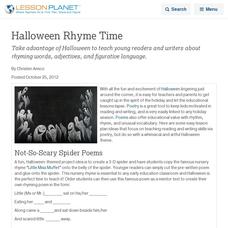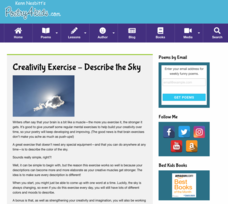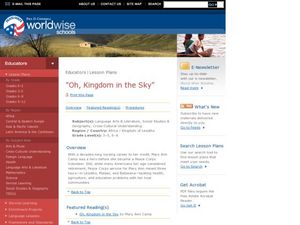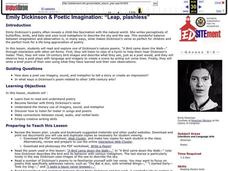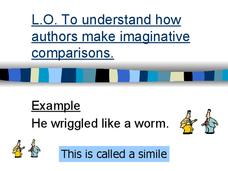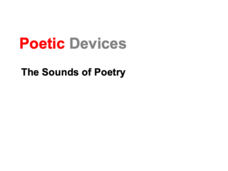Curated OER
Bringing Household Items to Life
Use folk tales as inspiration for learning about and using personification in creative writing. Learners brainstorm together in order to practice personification before writing their own poems or paragraphs about a household object.
Curated OER
Personification
Young writers discover that personification is when a writer gives an object the qualities of a person. After practicing identifying personification in many of the slides, individuals compose their own poem that uses this technique. They...
Curated OER
Sound poems
Third graders write a class poem based on the use of sound to create effects. They investigate use of onomatopoeia and how to write in a tight structure.
Curated OER
Halloween Rhyme Time
Take advantage of Halloween to teach young readers and writers about rhyming words, adjectives, and figurative language.
ReadWriteThink
Alliteration All Around
Discover alliteration found in picture books by Pamela Duncan Edwards. Then, dive into a read aloud of Alligators All Around by Maurice Sendak. This practice sets the stage for budding poets to create their own acrostic poem,...
Harper Collins
The Giving Tree Anniversary Teaching Guide
Celebrate poetry month all of April with a guide that uses six of Shel Silverstein's most famous books as a basis for the lessons. Discussion questions and writing activities are provided for each of Silverstein's books.
K12 Reader
Alliteration Animals
Bees buzz, dogs dig, lion laze, and snakes slither! Use alliteration to create sentences about four different animals.
Curated OER
Chasing Metaphors
Students use metaphors in order to see commonly experienced objects, events, and people in new and more meaningful ways.
Poetry4kids
Creativity Exercise - Describe the Sky
Scholars stretch their writing muscles with an exercise that asks them to describe the sky using similes and metaphors.
Curated OER
"Oh, Kingdom in the Sky"
Students write a poem. In this historical figures lesson, students learn about Mary Ann Camp, read an interview, read vignettes about life in her host countries and read her poem "Oh, Kingdom in the Sky." Students answer questions about...
Curated OER
Poetry: A Picture of Feelings
Students take a field trip to a place of interest. After the trip they share with a partner their most memorable memory about it. Later, they paint a picture representative of the trip and illustrate it with a poem using at least two...
Curated OER
Color Poems
Students describe colors. In this descriptive writing lesson, students brainstorm color descriptions using all of the senses except sight. Students write poems including similes, sensory images, and interesting word choice. Examples are...
Curated OER
Language Arts: Awesome Authors Website
Students examine the writing techniques of professional authors and apply them to their own work. In pairs, they email authors to discover the tricks of the trade. Students create their own Website for their work.
Curated OER
"Leap, Plashless": Emily Dickinson & Poetic Imagination
Students read and explore one of Emily Dickinson's nature poems, "A Bird Came Down the Walk-" through interaction with a variety of art forms. Clips of a hymn to hear meter and the viewing of bird images exposes them to the language and...
Curated OER
Camels Theme Unit
In this Camel themed worksheet, learners create an alliteration, an acrostic poem, and work with similes. The unit consist of three pages of language arts work, based on Camels.
Curated OER
All Aboard!
Learners recognize and identify onomatopoeia. They will read the book All Aboard! A True Train Story, by Susan Kuklin. After reading the book, they list and illustrate examples of onomatopoeia. Then they write a poem or...
Curated OER
Synonyms
Similes and Synonyms are the focus of this language arts presentation. After being introduced to similes and how they work, young writers practice writing similes about the sun by using phrases such as, "The sun is like a golden ring...
Curated OER
Synonyms - How Authors Make Comparisons
A very good 13-slide presentation on similes and metaphors is here for you. It introduces young poets to each term, gives examples, and prompts them to work together to identify similes and metaphors in several different sentences.
Curated OER
Poetry
What is the difference between a simile and a metaphor? Third graders read a poem as a class and chart all of the similes and metaphors they hear. They then discuss the differences between each literary device as well as what is being...
Laura Candler
Bio Poems Made Easy
A creative way bring autobiographical writing to your poetry unit or back-to-school curriculum, this lesson plan guides you through a bio poem activity. Kids use the graphic organizer to describe themselves using adjectives, things...
Poetry4kids
How to Write a Clerihew
Writing funny poems is the best part about learning poetic forms! Young poets learn all about clerihews—humorous four-line poems about people—with an explanatory lesson.
Worksheet Web
What did it Say? – Summarizing
Provide scholars with an opportunity to practice summarizing text with a two-page learning exercise. Learners read poems, share stories with their peers, and summarize their new-found-knowledge.
Ereading Worksheets
Poetic Devices: The Sounds of Poetry
Students review examples and definitions of different poetic devices. In this poetic devices lesson, students interact with the website by reading definitions and looking at examples of poetic devices such as onomatopoeia, repetition,...
School District No. 71
Adding Written Detail: Using Jane Yolen’s Owl Moon as a Mentor Text
Access your senses with a worksheet on sensory language. Based on Owl Moon by Jane Yolen, the worksheet prompts kids to find examples of each of the five senses, as well as phrases for inner emotion.



